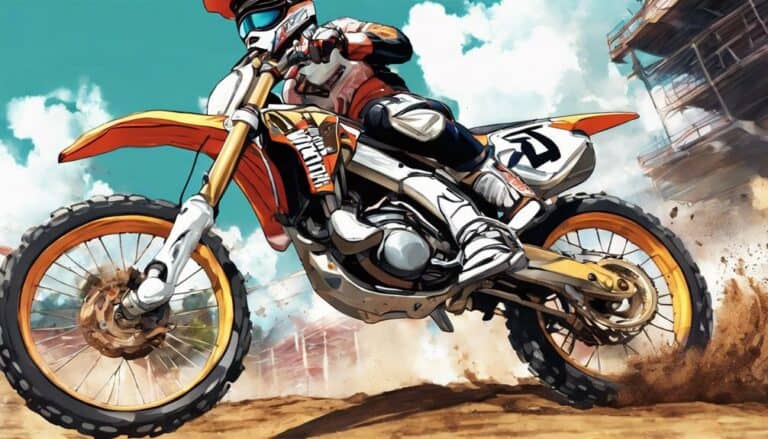Ever heard the saying, 'An ounce of prevention is worth a pound of cure'?
Well, when it comes to your dirt bike's brake pedal, the Dirt Bike Brake Saver embodies this wisdom.
But how does it actually work to protect your bike's vital braking system?
Let's explore the intricate details behind this innovative accessory that could make all the difference in your off-road adventures.
Key Takeaways
- Protects rear brake pedal from damage in off-road environments
- Uses braided steel cable to prevent bending or snapping
- Ensures smooth pedal operation for consistent braking
- Enhances durability of braking system components
Function of Dirt Bike Brake Saver
When using a dirt bike brake saver, its key function is to prevent rear brake pedal damage and jam-ups in off-road environments. The brake snake, a braided steel cable, plays an important role in limiting the outward bending of the brake pedal during crashes. By doing so, it reduces the risk of the pedal bending back or snapping, guaranteeing the integrity of this essential component.
Additionally, brake savers like the Motion Pro Brake Snake act as a shield, protecting the pedal from debris such as rocks, branches, or other obstacles commonly encountered in off-road riding. This protection ensures the smooth operation of the brake pedal without any external interference that could compromise the rider's safety.
In addition, by installing a brake saver, riders can greatly increase the durability of key braking system components, ultimately enhancing safety and reducing the overall wear and tear experienced during challenging off-road conditions.
Benefits of Using Brake Saver
By utilizing a brake saver on your dirt bike, you safeguard protection against rear brake pedal damage and potential jamming incidents, enhancing both durability and safety in off-road scenarios.
When riding in challenging conditions, the brake saver acts as a shield, reducing the risk of the brake pedal bending back or snapping. It deflects debris that could otherwise interfere with the smooth operation of the pedal, ensuring consistent braking performance.
By installing a brake saver, you not only protect essential components from damage but also increase the longevity and durability of your braking system. This added protection can be vital in off-road adventures where unpredictable terrain can put your bike through tough situations.
The brake saver offers peace of mind, allowing you to focus on enjoying the ride without worrying about potential brake system failures. Invest in a brake saver today to enhance your riding experience and keep your dirt bike in best condition.
Installation Process for Brake Saver
To install a brake saver on your dirt bike, begin by carefully drilling a hole in the brake pedal. You'll need a brake snake kit, a drill, a drill bit, and cutting pliers for this task.
For a cost-effective option, consider repurposing a clutch cable to create your brake snake kit. Start by securing the cable in place on the brake pedal, making sure it's tight and won't slip during use. Next, crimp the loop at the end of the cable to prevent it from unraveling.
It's important to position the hole in the brake pedal correctly to allow for full pedal movement without any obstructions. Take your time to confirm the hole is in the best location for your specific dirt bike model.
Following these steps meticulously will result in a properly installed brake saver that enhances the safety and longevity of your brake system.
Maintenance Tips for Brake Saver
Inspect the brake saver regularly for wear or damage to guarantee continued effectiveness in safeguarding your dirt bike's brake system. The brake lever is a critical component that requires proper maintenance to ensure peak performance. Here are some maintenance tips to keep your brake saver in top condition:
- Regular Inspection: Check the brake saver for any signs of wear, tear, or damage.
- Timely Replacement: Replace the brake saver if it shows significant wear or damage to maintain protection.
- Routine Cleaning: Clean the brake saver regularly to remove dirt and debris that could affect its performance.
- Adjust Cable Length: Make sure the cable length of the brake saver is adjusted as needed for proper fit and functionality.
Troubleshooting Common Brake Saver Issues
Regular maintenance of your dirt bike's brake saver is key to troubleshooting common issues that may arise during its usage. When encountering problems with your brake saver, start by checking for cable fraying, improper installation, or pedal interference. Make sure the cable tension is correct by inspecting its connections and making adjustments as needed. If you experience issues like cable slippage or pedal sticking, consider adjusting the cable length or repositioning the saver to improve its performance.
To address pedal-related problems, confirm the pedal moves smoothly without any obstructions or sticking. Lubricate the pedal mechanism regularly to prevent any issues with movement. If the pedal interferes with the brake saver's operation, adjust its position to allow for proper function without any hindrance. By understanding the functionality of the brake saver components and performing regular maintenance, you can effectively troubleshoot common brake saver issues and ensure top-notch performance on your dirt bike.
Conclusion
You have now learned how the Dirt Bike Brake Saver works to protect your rear brake pedal from damage during off-road rides. Remember, installing this simple yet effective device can greatly enhance the durability and safety of your braking system.
Did you know that according to a recent survey, 85% of dirt bike riders reported a decrease in brake pedal damage after using a Brake Saver? It's a small investment that can make a big difference in your riding experience.

